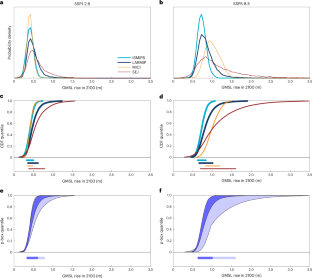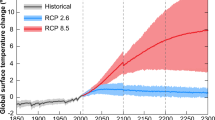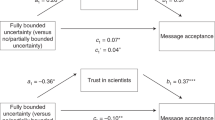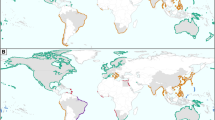Abstract
Future sea-level change is characterized by both quantifiable and unquantifiable uncertainties. Effective communication of both types of uncertainty is a key challenge in translating sea-level science to inform long-term coastal planning. Scientific assessments play a key role in the translation process and have taken diverse approaches to communicating sea-level projection uncertainty. Here we review how past IPCC and regional assessments have presented sea-level projection uncertainty, how IPCC presentations have been interpreted by regional assessments and how regional assessments and policy guidance simplify projections for practical use. This information influenced the IPCC Sixth Assessment Report presentation of quantifiable and unquantifiable uncertainty, with the goal of preserving both elements as projections are adapted for regional application.
This is a preview of subscription content, access via your institution
Access options
Access Nature and 54 other Nature Portfolio journals
Get Nature+, our best-value online-access subscription
$29.99 / 30 days
cancel any time
Subscribe to this journal
Receive 12 print issues and online access
$209.00 per year
only $17.42 per issue
Buy this article
- Purchase on Springer Link
- Instant access to full article PDF
Prices may be subject to local taxes which are calculated during checkout



Similar content being viewed by others
Data availability
The main AR6 sea-level projection data are available on Zenodo at https://doi.org/10.5281/zenodo.5914709 (ref. 94). A guide to additional related AR6 sea-level datasets is available at https://github.com/Rutgers-ESSP/IPCC-AR6-Sea-Level-Projections.
References
Abram, N. J. et al. in IPCC Special Report on the Ocean and Cryosphere in a Changing Climate (eds Pörtner, H.-O. et al.) 73–129 (Cambridge Univ. Press, 2019). Explains multiple contexts appropriate for applying the term ‘deep uncertainty’ and related terms such as ‘ambiguity' in assessments.
Ellsberg, D. Risk, ambiguity, and the Savage axioms. Q. J. Econ. 75, 643–669 (1961). Introduces the term ‘ambiguity’ as a metric of Knightian uncertainty.
Lempert, R. J., Popper, S. W. & Bankes, S. C. Shaping the Next One Hundred Years: New Methods for Quantitative, Long-Term Policy Analysis (RAND Corporation, 2003). Defines ‘deep uncertainty’.
Hawkins, E. & Sutton, R. The potential to narrow uncertainty in regional climate predictions. Bull. Am. Meteorol. Soc. 90, 1095–1107 (2009).
Moss, R. H. et al. The next generation of scenarios for climate change research and assessment. Nature 463, 747–756 (2010).
Fox-Kemper, B. et al. in Climate Change 2021: The Physical Science Basis (eds Masson-Delmotte, V. et al.) 1211–1362 (Cambridge Univ. Press, 2021).
Kopp, R. E. et al. Usable science for managing the risks of sea-level rise. Earths Future 7, 1235–1269 (2019).
Haasnoot, M., Kwakkel, J. H., Walker, W. E. & ter Maat, J. Dynamic adaptive policy pathways: a method for crafting robust decisions for a deeply uncertain world. Glob. Environ. Change 23, 485–498 (2013).
Haasnoot, M. et al. Generic adaptation pathways for coastal archetypes under uncertain sea-level rise. Environ. Res. Commun. 1, 071006 (2019).
Heal, G. & Millner, A. Reflections: uncertainty and decision making in climate change economics. Rev. Environ. Econ. Policy 8, 120–137 (2014).
New, M. et al. in Climate Change 2022: Impacts, Adaptation, and Vulnerability (eds Pörtner, H.-O. et al.) 2539–2654 (Cambridge Univ. Press, 2022).
Keller, K., Helgeson, C. & Srikrishnan, V. Climate risk management. Ann. Rev. Earth Planet. Sci. 49, 95–116 (2021).
State of California Sea-Level Rise Guidance: 2018 Update (California Ocean Protection Council & California Natural Resources Agency, 2018); https://www.slc.ca.gov/sea-level-rise/state-of-california-sea-level-rise-guidance-2018-update/
Hirschfeld, D. et al. Global survey shows planners use widely varying sea-level rise projections for coastal adaptation. Comm. Earth & Env. 4, 102 (2023).
Sea-Level Rise: Guidance for New Jersey (New Jersey Department of Environmental Protection, 2021); https://www.nj.gov/dep/bcrp/resilientnj/docs/dep-guidance-on-sea-level-rise-2021.pdf
Climate Resiliency Design Guidelines (New York City Mayor’s Office of Resiliency, 2020); https://www1.nyc.gov/assets/orr/pdf/NYC_Climate_Resiliency_Design_Guidelines_v4-0.pdf
Horton, B. P. et al. Mapping sea-level change in time, space and probability. Annu. Rev. Environ. Resour. 43, 481–521 (2018).
Hinkel, J. et al. Meeting user needs for sea-level rise information: a decision analysis perspective. Earths Future 7, 320–337 (2019).
Kirchhoff, C. J., Lemos, M. C. & Kalafatis, S. Narrowing the gap between climate science and adaptation action: the role of boundary chains. Clim. Risk Manag. 9, 1–5 (2015).
Lemos, M. C., Kirchhoff, C. J., Kalafatis, S. E., Scavia, D. & Rood, R. B. Moving climate information off the shelf: boundary chains and the role of RISAs as adaptive organizations. Weather Clim. Soc. 6, 273–285 (2014). Introduces the concept of ‘boundary chains’ linking boundary organizations together to advance the usability of science.
Guston, D. H. Boundary organizations in environmental policy and science: an introduction. Sci. Technol. Hum. Values 26, 399–408 (2001).
Oppenheimer, M. et al. Discerning Experts: The Practices of Scientific Assessment for Environmental Policy (Univ. Chicago Press, 2019). Details the history of WAIS projections from 1981 through IPCC AR4.
Nicholls, R. J. et al. Integrating new sea-level scenarios into coastal risk and adaptation assessments: an ongoing process. WIREs Clim. Change 12, e706 (2021).
Gieryn, T. F. Boundary-work and the demarcation of science from non-science: strains and interests in professional ideologies of scientists. Am. Soc. Rev. 48, 781–795 (1983).
Shackley, S. & Wynne, B. Representing uncertainty in global climate change science and policy: boundary-ordering devices and authority. Sci. Technol. Hum. Values 21, 275–302 (1996).
Star, S. L. & Griesemer, J. R. Institutional ecology, ‘translations’ and boundary objects: amateurs and professionals in Berkeley’s Museum of Vertebrate Zoology, 1907–39. Soc. Stud. Sci. 19, 387–420 (1989).
O’Reilly, J., Oreskes, N. & Oppenheimer, M. The rapid disintegration of projections: the West Antarctic Ice Sheet and the Intergovernmental Panel on Climate Change. Soc. Stud. Sci. 42, 709–731 (2012). Analyses the relationships between the IPCC and the WAIS research community.
Van der Sluijs, J., van Eijndhoven, J., Shackley, S. & Wynne, B. Anchoring devices in science for policy: the case of consensus around climate sensitivity. Soc. Stud. Sci. 28, 291–323 (1998).
Franco-Torres, M., Rogers, B. C. & Ugarelli, R. M. A framework to explain the role of boundary objects in sustainability transitions. Environ. Innov. Soc. Transit. 36, 34–48 (2020).
Adler, C. E. & Hirsch Hadorn, G. The IPCC and treatment of uncertainties: topics and sources of dissensus. WIREs Clim. Change 5, 663–676 (2014).
Aven, T. & Renn, O. An evaluation of the treatment of risk and uncertainties in the IPCC reports on climate change. Risk Anal. 35, 701–712 (2015).
Budescu, D. V., Broomell, S. & Por, H.-H. Improving communication of uncertainty in the reports of the Intergovernmental Panel on Climate Change. Psychol. Sci. 20, 299–308 (2009).
Budescu, D. V., Por, H.-H. & Broomell, S. B. Effective communication of uncertainty in the IPCC reports. Climatic Change 113, 181–200 (2012).
Dunwoody, S. & Kohl, P. A. Using weight-of-experts messaging to communicate accurately about contested science. Sci. Commun. 39, 338–357 (2017).
Friedman, S. M., Dunwoody, S. & Rogers, C. L. Communicating Uncertainty: Media Coverage of New and Controversial Science (Routledge, 1999).
Gustafson, A. & Rice, R. E. A review of the effects of uncertainty in public science communication. Public Underst. Sci. 29, 614–633 (2020).
Janzwood, S. Confident, likely, or both? The implementation of the uncertainty language framework in IPCC special reports. Climatic Change 162, 1655–1675 (2020).
Mach, K. J., Mastrandrea, M. D., Freeman, P. T. & Field, C. B. Unleashing expert judgment in assessment. Glob. Environ. Change 44, 1–14 (2017).
Patt, A. Assessing model-based and conflict-based uncertainty. Glob. Environ. Change 17, 37–46 (2007).
Swart, R., Bernstein, L., Ha-Duong, M. & Petersen, A. Agreeing to disagree: uncertainty management in assessing climate change, impacts and responses by the IPCC. Climatic Change 92, 1–29 (2009).
Mercer, J. H. West Antarctic ice sheet and CO2 greenhouse effect: a threat of disaster. Nature 271, 321–325 (1978).
Gornitz, V., Lebedeff, S. & Hansen, J. Global sea level trend in the past century. Science 215, 1611–1614 (1982). Seminal paper providing the first modern, scientific sea-level projections.
Warrick, R. A. & Oerlemans, J. in Climate Change: The IPCC Scientific Assessment (eds Houghton, J. T. et al.) 261–281 (Cambridge Univ. Press, 1990).
Warrick, R. A., Le Provost, C., Meier, M. F., Oerlemans, J. & Woodworth, P. L. in Climate Change 1995: The Science of Climate Change (eds Houghton, J. T. et al.) 359–406 (Cambridge Univ. Press, 1996).
Church, J. A. et al. in Climate Change 2001: The Scientific Basis (eds Houghton, J. T. et al.) 641–693 (Cambridge Univ. Press, 2001).
Lemke, P. et al. in Climate Change 2007: The Physical Science Basis (eds Solomon, S. et al.) 337–383 (Cambridge Univ. Press, 2007).
Vaughan, D. G. & Arthern, R. Why is it hard to predict the future of ice sheets? Science 315, 1503–1504 (2007).
Rahmstorf, S. A semi-empirical approach to projecting future sea-level rise. Science 315, 368–370 (2007).
Dean, C. Even before its release, world climate report is criticized as too optimistic. The New York Times (2 February 2007).
Meehl, G. A. et al. in Climate Change 2007: The Physical Science Basis (eds Solomon, S. et al.) 747–845 (Cambridge Univ. Press, 2007).
IPCC: Summary for Policymakers. In Climate Change 2007: The Physical Science Basis (eds Solomon, S. et al.) 2–18 (Cambridge Univ. Press, 2007).
Oppenheimer, M., O’Neill, B. C., Webster, M. & Agrawala, S. The limits of consensus. Science 317, 1505–1506 (2007).
Pfeffer, W. T., Harper, J. T. & O’Neel, S. Kinematic constraints on glacier contributions to 21st-century sea-level rise. Science 321, 1340–1343 (2008).
Katsman, C. et al. Exploring high-end scenarios for local sea level rise to develop flood protection strategies for a low-lying delta—the Netherlands as an example. Climatic Change 109, 617–645 (2011).
Lowe, J. A. et al. UK Climate Projections Science Report: Marine and Coastal Projections (Met Office Hadley Centre, 2009).
Church, J. A. et al. in Climate Change 2013: The Physical Science Basis (eds Stocker, T. F. et al.) 1137–1216 (Cambridge Univ. Press, 2013).
Church, J. A. et al. Sea-level rise by 2100. Science 342, 1445 (2013).
Collins, M. et al. in Climate Change 2013: The Physical Science Basis (eds Stocker, T. F. et al.) 1029–1136 (Cambridge Univ. Press, 2013).
IPCC: Summary for Policymakers. In Climate Change 2013: The Physical Science Basis (eds Stocker, T. F. et al.) 3–29 (Cambridge Univ. Press, 2013).
Bakker, A. M. R., Louchard, D. & Keller, K. Sources and implications of deep uncertainties surrounding sea-level projections. Climatic Change 140, 339–347 (2017).
Lee, J. Y. et al. in Climate Change 2021: The Physical Science Basis (eds Masson-Delmotte, V. et al.) 553–672 (Cambridge Univ. Press, 2021).
Hall, J. A. et al. Rising sea levels: helping decision-makers confront the inevitable. Coast. Manag. 47, 127–150 (2019). Reviews US efforts to generate sea-level scenarios.
Kopp, R. E. et al. Probabilistic 21st and 22nd century sea-level projections at a global network of tide gauge sites. Earths Future 2, 383–406 (2014).
Kopp, R. E. et al. Evolving understanding of Antarctic ice-sheet physics and ambiguity in probabilistic sea-level projections. Earths Future 5, 1217–1233 (2017).
Griggs, G. et al. Rising Seas in California—An Update on Sea-Level Rise Science (California Ocean Science Trust, 2017).
Gornitz, V. et al. New York City Panel on Climate Change 2019 Report Chapter 3: Sea level rise. Ann. NY Acad. Sci. 1439, 71–94 (2019).
Sweet, W. V. et al. Global and Regional Sea Level Rise Scenarios for the United States (National Oceanic Atmospheric Administration, 2017); https://doi.org/10.7289/v5/tr-nos-coops-083
Boesch, D. F. et al. Updating Maryland’s Sea-Level Rise Projections. Special report of the Scientific and Technical Working Group to the Maryland Climate Change Commission (Univ. Maryland Center for Environmental Science, 2018).
DeConto, R. M. & Pollard, D. Contribution of Antarctica to past and future sea-level rise. Nature 531, 591–597 (2016).
Kopp, R. E. et al. New Jersey’s Rising Seas and Changing Coastal Storms: Report of the 2019 Science and Technical Advisory Panel (Rutgers, State Univ. New Jersey, 2019); https://doi.org/10.7282/t3-eeqr-mq48
Rasmussen, D. J. et al. Extreme sea level implications of 1.5 °C, 2.0 °C, and 2.5 °C temperature stabilization targets in the 21st and 22nd centuries. Environ. Res. Lett. 13, 034040 (2018).
Bamber, J. L., Oppenheimer, M., Kopp, R. E., Aspinall, W. P. & Cooke, R. M. Ice sheet contributions to future sea-level rise from structured expert judgment. Proc. Natl Acad. Sci. USA 116, 11195–11200 (2019). SEJ study of the potential ice-sheet contribution to sea-level rise.
Oppenheimer, M. et al. in IPCC Special Report on the Ocean and Cryosphere in a Changing Climate (eds Pörtner, H.-O. et al.) 321–445 (Cambridge Univ. Press, 2019).
Eyring, V. et al. Overview of the Coupled Model Intercomparison Project Phase 6 (CMIP6) experimental design and organisation. Geosci. Model Dev. 9, 1937–1958 (2016).
IPCC: Summary for Policymakers. In IPCC Special Report on the Ocean and Cryosphere in a Changing Climate (eds Pörtner, H.-O. et al.) 3–35 (Cambridge Univ. Press, 2019).
Schlegel, N.-J. et al. Exploration of Antarctic Ice Sheet 100-year contribution to sea level rise and associated model uncertainties using the ISSM framework. Cryosphere 12, 3511–3534 (2018).
Edwards, T. L. et al. Projected land ice contributions to twenty-first-century sea level rise. Nature 593, 74–82 (2021). Emulates the ice-sheet and glacier response to warming based on multi-model comparison exercises.
Nowicki, S. et al. Experimental protocol for sea level projections from ISMIP6 stand-alone ice sheet models. Cryosphere 14, 2331–2368 (2020).
Nowicki, S. M. J. et al. Ice Sheet Model Intercomparison Project (ISMIP6) contribution to CMIP6. Geosci. Model Dev. 9, 4521–4545 (2016).
Levermann, A. et al. Projecting Antarctica’s contribution to future sea level rise from basal ice shelf melt using linear response functions of 16 ice sheet models (LARMIP-2). Earth Syst. Dyn. 11, 35–76 (2020).
Aschwanden, A., Bartholomaus, T. C., Brinkerhoff, D. J. & Truffer, M. Brief communication: a roadmap towards credible projections of ice sheet contribution to sea level. Cryosphere 15, 5705–5715 (2021).
DeConto, R. M. et al. The Paris Climate Agreement and future sea-level rise from Antarctica. Nature 593, 83–88 (2021). Models the Antarctic contribution to sea-level rise while including the potential for MICI.
Riahi, K. et al. in Climate Change 2022: Mitigation of Climate Change (eds Shukla, P. R. et al.) 295–408 (Cambridge Univ. Press, 2022).
Crawford, A. J. et al. Marine ice-cliff instability modeling shows mixed-mode ice-cliff failure and yields calving rate parameterization. Nat. Commun. 12, 2701 (2021).
Schlemm, T., Feldmann, J., Winkelmann, R. & Levermann, A. Stabilizing effect of mélange buttressing on the marine ice-cliff instability of the West Antarctic Ice Sheet. Cryosphere 16, 1979–1996 (2022).
Bassis, J. N., Berg, B., Crawford, A. J. & Benn, D. I. Transition to marine ice cliff instability controlled by ice thickness gradients and velocity. Science 372, 1342–1344 (2021).
IPCC: Summary for Policymakers. In Climate Change 2021: The Physical Science Basis (eds Masson-Delmotte, V. et al.) 3–32 (Cambridge Univ. Press, 2021).
Arias, P. A. et al. in Climate Change 2021: The Physical Science Basis (eds Masson-Delmotte, V. et al.) 33–144 (Cambridge Univ. Press, 2021).
Chen, D. et al. in Climate Change 2021: The Physical Science Basis (eds Masson-Delmotte, V. et al.) 147–286 (Cambridge Univ. Press, 2021).
Shepherd, T. G. et al. Storylines: an alternative approach to representing uncertainty in physical aspects of climate change. Climatic Change 151, 555–571 (2018).
Stammer, D. et al. Framework for high-end estimates of sea level rise for stakeholder applications. Earths Future 7, 923–938 (2019).
Slangen, A. B. A., Haasnoot, M. & Winter, G. Rethinking sea-level projections using families and timing differences. Earth’s Future 10, e2021EF002576 (2022).
Kopp, R. E. et al. The Framework for Assessing Changes To Sea-level (FACTS) v1.0-rc: a platform for characterizing parametric and structural uncertainty in future global, relative, and extreme sea-level change. Preprint at EGUsphere https://doi.org/10.5194/egusphere-2023-14 (2023).
Garner, G. G. et al. IPCC AR6 sea level projections. Version 20210809. Zenodo https://doi.org/10.5281/zenodo.5914709 (2021).
Knight, F. H. Risk, Uncertainty and Profit (Houghton Mifflin, 1921).
Mastrandrea, M. D. et al. Guidance Notes for Lead Authors of the IPCC Fifth Assessment Report on Consistent Treatment of Uncertainties (IPCC, 2010). Defines the current IPCC usage of likelihood and confidence terms.
Le Cozannet, G., Manceau, J.-C. & Rohmer, J. Bounding probabilistic sea-level projections within the framework of the possibility theory. Environ. Res. Lett. 12, 014012 (2017).
Tucker, W. T. & Ferson, S. Probability Bounds Analysis in Environmental Risk Assessments (Applied Biomathematics, 2003).
Sweet, W. V. et al. Global and Regional Sea Level Rise Scenarios for the United States: Updated Mean Projections and Extreme Water Level Probabilities Along U.S. Coastlines (National Oceanic and Atmospheric Administration National Ocean Service, 2022); https://oceanservice.noaa.gov/hazards/sealevelrise/noaa-nos-techrpt01-global-regional-SLR-scenarios-US.pdf
Collini, R. C. et al. Application Guide for the 2022 Sea Level Rise Technical Report (National Oceanic and Atmospheric Administration Office for Coastal Management, 2022); https://oceanservice.noaa.gov/hazards/sealevelrise/noaa-nos-techrpt02-global-regional-SLR-scenarios-US-application-guide.pdf
Acknowledgements
We thank other members of the SROCC chapter 4 and AR6 chapter 9 teams, as well as J. Fyfe, for conversations on the chapter and SPM drafting processes. We thank M. Campo for helpful comments on the manuscript. R.E.K. and M.O. were supported by US National Science Foundation award ICER-2103754 as part of the Megalopolitan Coastal Transformation Hub. R.E.K. and G.G.G. were also supported by the US National Aeronautics and Space Administration (award 80NSSC20K1724 and JPL task 105393.509496.02.08.13.31). J.L.O. was supported by US National Science Foundation award 1643524. H.T.H. and M.D.P. were supported by the Met Office Hadley Centre Climate Programme funded by the UK Department for Science, Innovation, and Technology and Department for Environment, Food and Rural Affairs. B.F.-K. was supported by the National Oceanic and Atmospheric Administration (NA19OAR4310366) and Schmidt Futures (Scale-Aware Sea Ice Project). S.N. was supported by the US National Aeronautics and Space Administration (awards 80NSSC21K0915 and 80NSSC21K0322). N.R.G. was supported by the Ministry of Business, Innovation and Employment, New Zealand (grants RTUV1705 and ANTA1801) and Royal Society Te Apārangi (grant VUW-1501). B.P.H. was supported by the Singapore Ministry of Education Academic Research Fund (MOE2019-T3-1-004), National Research Foundation Singapore and Singapore Ministry of Education under the Research Centres of Excellence initiative. A.B.A.S. and T.L.E. were supported by the European Union’s Horizon 2020 research and innovation programme (PROTECT; grant agreement number 869304). T.L.E. was also supported by the UK Natural Environment Research Council (NE/T007443/1). This work is Earth Observatory of Singapore contribution 533 and PROTECT contribution number 67. The opinions and conclusions expressed herein are those of the authors, not necessarily those of their funding agencies, their institutions, the IPCC, other assessment authors or assessment conveners.
Author information
Authors and Affiliations
Corresponding author
Ethics declarations
Competing interests
All of the authors have participated in the IPCC in a variety of capacities. R.E.K. (California, New York City, Maryland, New Jersey, USA), M.O. (New York City), S.S.D. (the Netherlands), T.L.E. (UK) and M.D.P. (UK, Singapore) were involved in some of the national and subnational assessments discussed.
Peer review
Peer review information
Nature Climate Change thanks Donald Boesch, Padraig Murphy and the other, anonymous, reviewer(s) for their contribution to the peer review of this work.
Additional information
Publisher’s note Springer Nature remains neutral with regard to jurisdictional claims in published maps and institutional affiliations.
Supplementary information
Supplementary Information
Supplementary Tables 1 and 2 and Figs. 1–13.
Rights and permissions
Springer Nature or its licensor (e.g. a society or other partner) holds exclusive rights to this article under a publishing agreement with the author(s) or other rightsholder(s); author self-archiving of the accepted manuscript version of this article is solely governed by the terms of such publishing agreement and applicable law.
About this article
Cite this article
Kopp, R.E., Oppenheimer, M., O’Reilly, J.L. et al. Communicating future sea-level rise uncertainty and ambiguity to assessment users. Nat. Clim. Chang. 13, 648–660 (2023). https://doi.org/10.1038/s41558-023-01691-8
Received:
Accepted:
Published:
Issue Date:
DOI: https://doi.org/10.1038/s41558-023-01691-8



